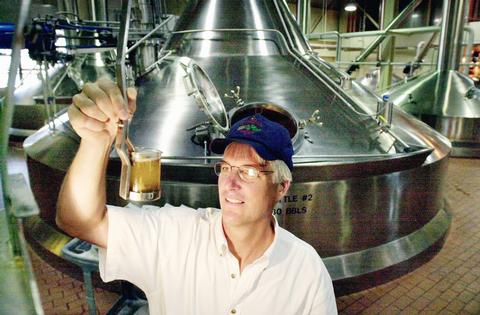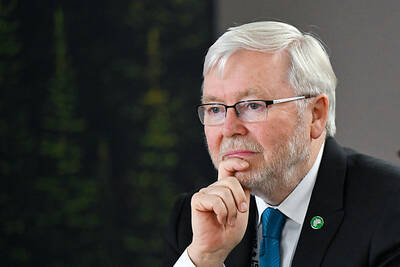Michael Poley has the kind of job that dreams are made of.
Brewmaster.

PHOTO: NY TIMES
Five days a week, Poley's task -- and many would say it's a rather enviable one -- is to test, test, and retest the beer that flows through the Anheuser-Busch plant in the hills near Cartersville, Georgia. At 50, he's been doing this kind of thing his entire working life and isn't close to tiring of it. He even buys all kinds of beer at the store so he can test them at home.
"Tasting the beer is the part I love about the job," Poley says.
Such jobs are fairly rare. For example, Coca-Cola Enterprises, which bottles most Coke products in the US, has 17 lab technicians at its plants in Marietta and College Park who are trained as taste testers. Most have backgrounds in chemistry or microbiology.
You might wonder: Is the life of a taste tester really all that fun? Yes, says Poley: "It's a blend of art and science."
Poley is a native Californian and, for a guy who drinks beer all day, remains remarkably thin. As brewmaster at the Anheuser-Busch plant, he oversees production of 20 brands.
He's so interested in the process of making beer and wine that he once tried to start his own vineyard (a failure, by the way, because he couldn't coax a good grape crop from his property in Georgia).
Poley is part of a select group. Anheuser-Busch, as big as it is, has only 12 breweries in the US and two abroad. The Cartersville plant is the newest; it shipped its first beer in 1993.
For Poley, every day is about trying to make new Bud taste just like yesterday's. August Busch III, the company's president and chairman, tests beer from every brewery, and brewmasters from different plants swap samples.
Keeping a working-man's brew like Bud the same might sound simple. But brewing is filled with variables that aren't found in making a product like Coke Classic.
Budweiser ferments for six days, then sits for another 21 in giant tanks for aging.
Poley and a handful of other taste-testers at the plant have a session each day, either late in the morning or in mid-afternoon.
The room where this happens is high atop the brewery, with windows that overlook the plant and, beyond that, the hills and trees of northwest Georgia. It is a surprisingly opulent space, with dark wood cabinets and black granite counters. A table surrounded by plush chairs looks like it would fit in a corporate boardroom.
The taste-testing lineup includes ingredients -- water from nearby Lake Allatoona and barley malt that originates on farms stretching from Montana to the Dakotas -- as well as finished beer.
Malt gives beer much of its flavor. Samples appear in a lineup of small bags, each filled with malt from the trucks and train cars that arrive at the plant.
Poley knows by taste whether the grain is right.
"It should be sweet. It should be somewhat toasted," he says. Before joining Anheuser-Busch, he once worked as a "maltster" at another company. His whole job was to manage the process that turns plain barley into barley malt.
Noticing subtle differences in beer takes time to learn, and not everyone can do it. Even Poley loses his sense sometimes. A cold can throw him off. That's why there are others who taste the beer.
Unlike wine tasting, this isn't a sip-and-spit occasion. Beer is bitter, and people taste bitterness on the back of the tongue. That means every taster has to swallow the samples.
But there are limits -- the samples add up to a maximum of about two bottles -- so staffers aren't woozy at the end of the day. Also, beer wears down the senses.
"You can fatigue your palate pretty quickly," Poley said. "You're really limited on how much you can do."
Even after trying brews all day, Poley likes sampling other beers, including micro-brews. But he claims that when he's sitting around the house, his favorites are still Bud and Bud Light.
Then again, that might be just an extension of the workday. "We're a little bit obsessive, I think."

NEXT GENERATION: The four plants in the Central Taiwan Science Park, designated Fab 25, would consist of four 1.4-nanometer wafer manufacturing plants, TSMC said Taiwan Semiconductor Manufacturing Co (TSMC, 台積電) plans to begin construction of four new plants later this year, with the aim to officially launch production of 2-nanometer semiconductor wafers by late 2028, Central Taiwan Science Park Bureau director-general Hsu Maw-shin (許茂新) said. Hsu made the announcement at an event on Friday evening celebrating the Central Taiwan Science Park’s 22nd anniversary. The second phase of the park’s expansion would commence with the initial construction of water detention ponds and other structures aimed at soil and water conservation, Hsu said. TSMC has officially leased the land, with the Central Taiwan Science Park having handed over the

The Philippines is working behind the scenes to enhance its defensive cooperation with Taiwan, the Washington Post said in a report published on Monday. “It would be hiding from the obvious to say that Taiwan’s security will not affect us,” Philippine Secretary of National Defense Gilbert Teodoro Jr told the paper in an interview on Thursday last week. Although there has been no formal change to the Philippines’ diplomatic stance on recognizing Taiwan, Manila is increasingly concerned about Chinese encroachment in the South China Sea, the report said. The number of Chinese vessels in the seas around the Philippines, as well as Chinese

AUKUS: The Australian Ambassador to the US said his country is working with the Pentagon and he is confident that submarine issues will be resolved Australian Ambassador to the US Kevin Rudd on Friday said that if Taiwan were to fall to China’s occupation, it would unleash China’s military capacities and capabilities more broadly. He also said his country is working with the Pentagon on the US Department of Defense’s review of the AUKUS submarine project and is confident that all issues raised will be resolved. Rudd, who served as Australian prime minister from 2007 to 2010 and for three months in 2013, made the remarks at the Aspen Security Forum in Colorado and stressed the longstanding US-Australia alliance and his close relationship with the US Undersecretary

‘WORLD WAR III’: Republican Representative Marjorie Taylor Greene said the aid would inflame tensions, but her amendment was rejected 421 votes against six The US House of Representatives on Friday passed the Department of Defense Appropriations Act for fiscal 2026, which includes US$500 million for Taiwan. The bill, which totals US$831.5 billion in discretionary spending, passed in a 221-209 vote. According to the bill, the funds for Taiwan would be administered by the US Defense Security Cooperation Agency and would remain available through Sept. 30, 2027, for the Taiwan Security Cooperation Initiative. The legislation authorizes the US Secretary of Defense, with the agreement of the US Secretary of State, to use the funds to assist Taiwan in procuring defense articles and services, and military training. Republican Representative